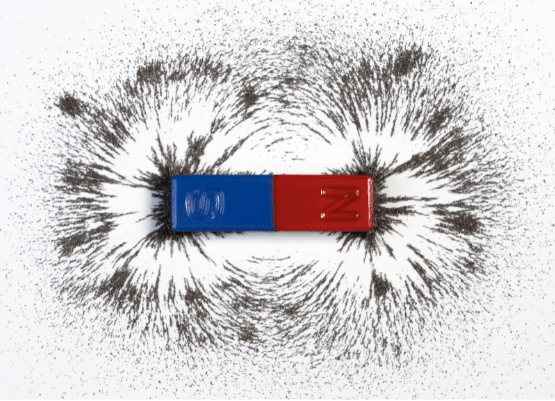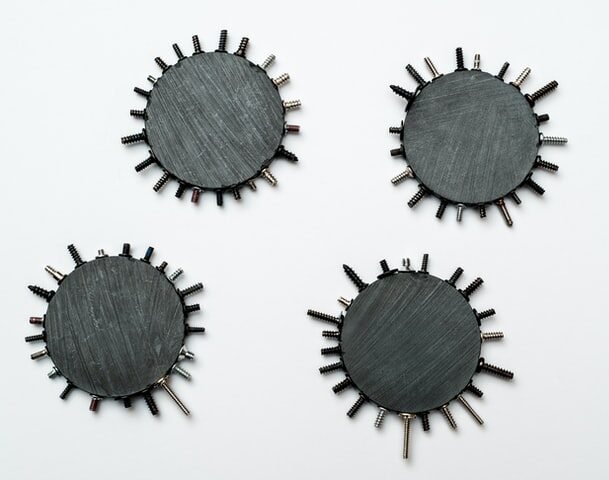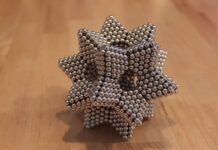When you’re about to buy magnets, you be reminded of the question do magnets lose power over time. The simple answer to this question is that demagnetization though a slow process, happens over time. It will degrade the strength of the magnet.
The so-called permanent magnets are vulnerable to losing their power. Since the magnets are made of magnetic domains and atoms, they have electrons spinning, vulnerable to losing their quality over time.
The alignment is damaged over time as a result of heat and stray electromagnetic fields, and it weakens the level of magnetism. The process is slow, however: a modern samarium-cobalt magnet usually takes around 700 years to lose half its strength.
Table of Contents
Do magnets lose strength?

Yes, magnets also can degrade in terms of their strength. But there are several factors it depends on. Retaining the magnetism forever isn’t ever possible. But when you take care of the permanent magnets correctly, they can stay with their magnetism intact for around a hundred years. In this article, you will get the opportunity of exploring some thoughts on the topic will magnets lose their power over time.
Remember that without influence from any external factors, the magnet can retain power up to centuries. However, certain other factors like the high temperatures, electrical current are the reasons that can degrade the quality.
Do magnets weaken over time? Yes, they do, and that’s because of the stray magnetic field, humidity radiation, and damage.
Do magnets wear out? Yes, just like the magnets are vulnerable to losing their power overtime, they are also susceptible to wearing out due to the numerous reasons.
Do magnets lose their magnetism over time?-the factors that cause demagnetization of the magnet

Do magnets lose their power over time? The simple answer to this question is magnets do completely wear away over time. There are many reasons behind the same. The permanent magnets retain power proving to be lasting long but are not intended for remaining unchanged. So here are the factors that cause the demagnetization of the magnet.
Magnets can lose power over time, and in the absence of external influences, an industrial magnet alloy hypothetically remains magnetic for hundreds of years.
Magnets used in real-world applications are susceptible to experiencing external demagnetizing conditions. An even partially demagnetized magnet negatively impacts operational performance, resulting in failures in the field.
Several variables contribute to magnetic performance degradation.
A magnet’s inherent properties influence the magnet to become demagnetized. Demagnetization can also occur due to the alteration of physical properties. Factors that affect the demagnetization of a magnet include:
- Heat
- External charges charges
- Physical damage
- Getting old
- Reluctant changes
- Magnet geometry
- Volume loss
- Intrinsic coercive force
Heat
When the magnet is exposed to high amounts of heat above the Curie point for the ferromagnetic materials, they can lose the magnetism. Depending on the amount of heat that you are applying, it can disrupt the magnet. When it is not heated up to the Curie point, the magnet restores its quality. Once it’s back to room temperature, it will be in its normal state.
You can also try out the remagnetization with the help of another magnet. The opposing magnetic field that damages sometimes causes permanent destruction of the magnetism property. You can restore the magnet’s power, but coercivity refers to the resistance of the magnetic material for changing magnetization.
That said, it gives the ability to withstand the external magnetic field without facing trouble due to demagnetization. When you choose to treat the magnets with care, they will stay longer. Temperature variation causes magnets to lose some or all magnetic charge. The data is different for every type and material, and so you should go through manufacturers’ terms while purchasing your magnet.
When the magnet is heated above the maximum operating point, a percentage of the magnet’s volume is demagnetized, and in that case, the magnetic loss will not be recovered upon cool down. Recovery then requires re-magnetizing the magnet.
The maximum operating point is geometry specific. Magnet providers specify a maximum operating temperature for various grades of alloy. The noted upper operating temperature assumes the magnet has an appropriate geometry for tolerating the heat level of the selected alloy grade. However, the advertised maximum operating temperature for a particular magnet alloy grade always is not sufficient to ensure elevated temperature performance.
For optimum operational heat resistance, the magnetic length, or L/D ratio, of the magnet must be sufficiently “long” relative to the area of the pole. 0.250” OD x 0.250” long neodymium magnet, oriented and magnetized through the length, has a magnetic length to pole diameter of L/D = 1. It turns out to be a highly effective L/D ratio, so the magnet should be capable of performing at the advertised upper operating temperature without irrecoverable loss.
On the contrary, a magnet that is 0.250” OD x 0.125” in length has an L/D = 0.5, indicating that the advertised maximum temperature of the magnet must be adjusted downward or a higher heat grade selected. L/D ratios over 0.7 turn out to be appropriate for the recommended operating temperatures advertised for neodymium magnets. However, it is advisable to consult an expert and execute thermal testing.
External Charges
Do magnets lose their strength? Note that all kinds of magnets do so strength. Magnets not protected from outside magnetic fields fall prey to the loss of magnetic charge. Magnets with certain properties become more susceptible to this effect. Alnico is one of such magents. External magnetic fields lead to demagnetization and can happen in multiple ways. The most common ones are environmental issues and improper storage.
Electromagnets and coils nearby can be the cause of the disruption. Storage of magnets near each other causes loss of magnetic charge since the opposing forces affect them continuously. Radiation too becomes a concern in the preservation of magnetic charge. So, if you don’t want to see the loss of the magnetic property, make sure to keep away magnets from moderate or high levels of radiation.
Physical damage
The magnetic separator dropped or exposed to heat can cause a loss of magnetic power. Such damage occurs due to external forces. Whenever you are unaware of the magnetic separation capabilities, there are more chances of facing this issue. Metallurgy changes happen only when the magnets are exposed to a high temperature. The manufacturers also have the most extreme temperatures that are set for every valuation of the material.
Getting Old
With time, the magnet weakens its strength. Though there are changes, yet the changes are very slow. Some other factors have a greater total effect. After a certain period of aging, the magnets don’t last a very long time.
Reluctant Changes
When your concern is do magnets lose power, remember operating slope of a magnet modification means that the variance can cause a shift in magnetic charge. You can get that with the displacement from a circuit, such as considering the operating magnet or placing on in a circuit. Besides, you can also feel the changes with changing the magnet properties while it is in use. The level of magnetic charge that finds reduction by this is dependent upon how extreme the alterations are. Besides, there is also the role of the properties of the magnet.
Magnet geometry
The inherent geometry of a magnet is responsible for influencing the magnet alloy’s ability to tolerate demagnetization due to external and internal influences. The more ideal the geometry of a magnet, the better the resistance to self-demagnetizing, elevated temperatures, as well as external demagnetizing fields.
The geometry of a magnet also gets reduced to a simple ratio — the Magnetic Length / Effective Pole Diameter (L/D). The magnetic length refers to the physical dimension of the magnet in the direction of magnetization. The effective pole diameter refers to the diameter of the pole region or the equivalent diameter for a non-circular pole.
The higher the L/D ratio, the more effectively the magnet resists demagnetization. Achieving this resistance requires more magnet volume and higher cost. Higher L/D ratios result in higher magnetic performance, but this correlation is not linear, and in this regard, that magnet quickly reaches a point of diminishing returns relative to the L/D ratio.
Volume loss
The most prominent performance degradation is due to a reduction of the magnet’s volume. Sometimes this reduction occurs due to mechanical impact, where a portion of the magnet gets fractured from the main body; however, volume loss can also be caused by corrosion.
Typically, a loss of performance due to corrosion or fracturing is visually obvious, but sometimes where a seemingly intact magnet can partially demagnetize, there will be a chance of performance degradation.
Intrinsic Coercive Force (HCI)
The Intrinsic Coercive Force (HCI) is indicative of the magnet alloy’s ability to withstand heat and demagnetization from external magnetic fields. The table of Neodymium alloy grades reveals the increase in operating temperature correlating to an increase in intrinsic coercive force. Also, the condition holds true for the magnet’s ability to withstand an external demagnetizing field. When the Intrinsic Coercive Force is higher then, the magnet withstands external demagnetizing fields more effectively.
Higher Intrinsic Coercive Force in a magnet material adds cost, and this is one of the prime reasons why the Hci level should be matched specifically to the application. Enhancing A Neo magnet’s HCI is possible by adding various materials to the crystal lattice. The most prominent material added is dysprosium, which is often very expensive.
Additionally, adding materials to the lattice reduces the effective energy of the Neo alloy. Thus, high grades of Neo with high operating temperatures are usually difficult to manufacture, expensive, or have limited availability. These issues result in the Neodymium grades of 50 having an Intrinsic Coercive Force of ~ 14 kilo-Oersted and a lower tolerance to heat.
Highlight on the property of the ferrite magnets

While you’re questioning can magnets lose their power, it’s worth getting a notion of the property of the ferrite magnets. Ferrite magnets are also referred to as hobby magnets or fridge magnets. These are the ones that are resistant to becoming demagnetized and also have high permeability.
Moreover, they do not rust over time. They are rust-proof and also can withstand heat up to 250 degrees Celsius. You can also find that they are fairly cheap compared to many other magnets. But they are not so strong in power as those of the neodymium magnets.
Highlight on the neodymium magnets
Neodymium magnets are also referred to as power magnets. These are the ones that present The Incredible force and the most powerful material. They have the strongest permanent magnetic power. They are quite expensive compared to the ferrite magnets and are vulnerable to getting affected by corrosion. But if you want to purchase magnets that can hold the lasting property for a longer time, it’s worth investing in them.
Polarized magnets and demagnetizing impact
Presenting the polarized magnets to restricting outside fields makes sure our generation of the magnetizing effect. In this case, the antagonistic fields start processing by presenting the configured conductors while also promoting the magnets to contact other magnets or any other kind of ferrous material. The different elements are vulnerable to vibration and shock. The thing that one must note is that a large portion of today’s materials are quite fragile and also splitting. This is a reason that can cause the demagnetization of the magnet in no time.
Determining the Optimum Magnet Grade to Reduce Demagnetization
One should never fall for advertised temperature performance values without first understanding the impact of the magnetic length / effective pole diameter ratio (L/D), as well as the intended operating environment.
To determine the required grade of Neo magnet alloy for your application, perform an analysis of the magnet’s operating condition, and it is especially true when the magnet experiences high temperatures and demagnetizing fields during operation.
Pauli’s exclusion principle
Pauli’s exclusion principle states that electrons present in the same orbital shell have opposite spins and cancel each other’s magnetic prowess. In certain elements, including iron and cobalt (ferromagnetic materials), the final valence shell is only half-filled and contains unpaired electrons.
These unpaired electrons, with no opposing electrons to neutralize them, collectively bestow their respective atoms with magnetic powers. When it comes to forming a crystal, atoms can either align their magnetic moments in the same direction or not, but it is dependent on what results in the least internal energy. Regions where the individual magnetic moments are parallel to each other (aligned) are referred to as magnetic domains.
When every magnetic domain is aligned in the same direction after the application of an external magnetic field, then an element or material starts behaving like a permanent magnet.
The magnetic field of permanent magnets is not permanent. Materials known as permanent magnets have magnetic domains, where electrons are aligned in pairs within atoms.
Damage to the alignment caused by heat and electromagnetic fields weakens Magnetism. Samarium-cobalt magnets lose nearly half their strength over 700 years.
In the absence of external influences, the magnetic properties of an alloy usually last for hundreds of years. Ageing result in a slightly diminished magnetic field, but the alloy should remain a good source of magnetic fields.
Most magnets are susceptible to many external demagnetizing conditions. A partially demagnetized magnet greatly impacts performance, leading to failure.
How do you recharge a magnet?
Recharge a magnet that has lost some of its original charges with a stronger magnet. Try rubbing a heavy-duty, strong magnet against the weaker one, with the utilization of linear strokes in one direction for about 15 minutes.
FAQs
Any magnet slowly weakens over time. The problem starts with the distortion in the magnetic domains.
Magnet doesn’t tend to lose power unless dropped or experiences another force responsible for misaligning the atoms.
Magnets lose their magnetic charge to temperature variations that either cause temporary or permanent losses. Heat is applied to magnets, causing them to temporarily lose strength but regain their force after being cooled down to their optimal operating temperatures.
A permanent magnet, when kept and used in optimum working conditions, keeps its magnetism for years and years. Neodymium magnet loses approximately 5% of its magnetism every 100 years.
Magnets that lose their strength let you recharge some of their original charges. Find a very strong magnet and repeatedly rub it across the weakened magnet. In this way, the strong magnet will realign the magnetic domains inside the weakened magnet.
- Do neodymium magnets lose their gripping power over time?
Yes, neodymium magnets do lose a negligible amount of magnetism. The reasons behind them are mechanical damage, corrosion, heat, and improper storage.
- How long does it take for a magnet to lose its power?
Depending on the property of the magnet, it loses power. Temporary magnet loses its magnetization in less than 1 hour while the Neodymium magnets lose 1% strength over ten years. Again, the Permanent magnets like sintered Nd-Fe-B magnets remain magnetized indefinitely.
- Do magnets lose magnetism?
At 80 °C, a magnet loses magnetism and becomes demagnetized permanently. Exposure to high temperature and heating above Curie temperature spoils the magnet.
- Will magnet lose its magnetism in water?
No, rather, it’s worth considering that magnets find a use for underwater recovery.
Final words
You’ve got the answer to the query do magnets lose power over time. Whether you are buying magnets for office, hobby, home, or industrial use, just protect your new purchase. This decision can make sure that the magnet lasts long and stay strong for longer periods. While you buy them, check for the durability level, and give the optimal care to prolong the life.








